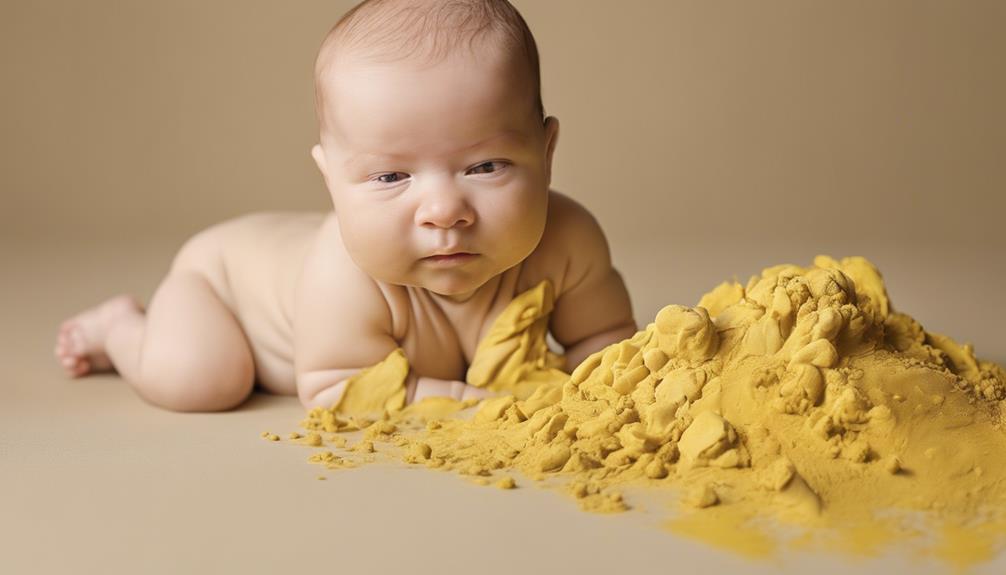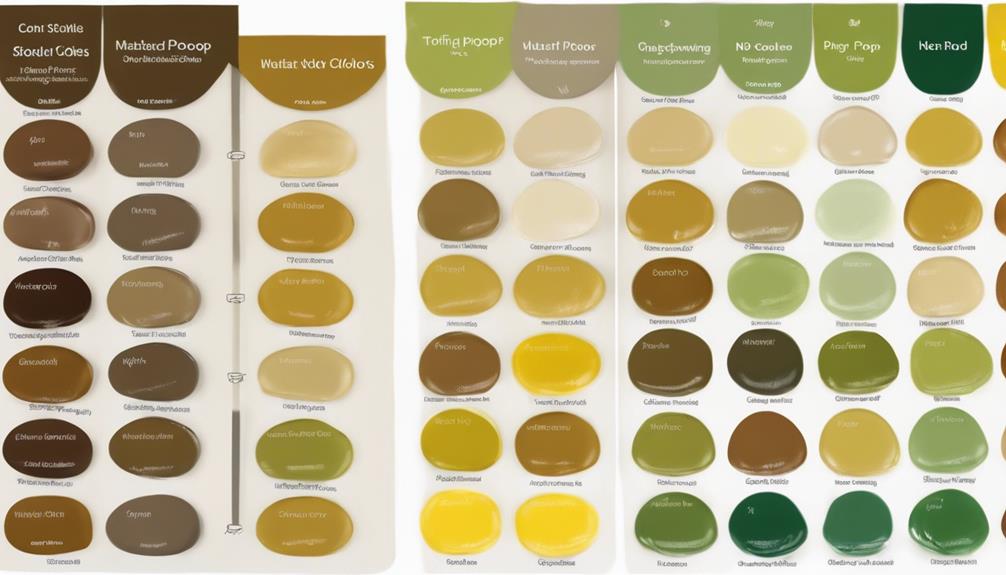As many as 8 out of 10 new parents may find themselves puzzled by the array of colors they encounter in their newborn's diaper. Understanding what's considered normal when it comes to a baby's poop can provide reassurance and help navigate potential concerns.
From the initial black tar-like meconium to the eventual shift to more familiar hues, the colors and textures of a baby's bowel movements can offer valuable insights into their well-being.
So, let's unravel the mystery behind normal newborn poop colors together, ensuring you're equipped to confidently monitor your little one's health.
Key Takeaways
- Meconium to yellow, seedy poop signals healthy digestion.
- Green poop may indicate infections or dietary factors.
- Abnormal colors like red, white, or clay require medical attention.
- Monitoring poop color aids in detecting underlying health issues.
Common Colors of Newborn Poop
When observing the common colors of newborn poop, it's important to note the distinct variations that indicate the shift from meconium to regular bowel movements. Initially, babies pass meconium, which is dark green or black. As the change progresses, the stools become less sticky and turn green, marking the move towards regular bowel movements.
For breastfed babies, their poop typically adopts a mustard yellow hue with a seedy texture, reflecting the digestion of breast milk. On the other hand, formula-fed infants may have poop ranging from yellow to brown, resembling the consistency of peanut butter.
Understanding these color changes is essential for parents to monitor their baby's health and digestion. The evolution from dark meconium to green transitional stools and finally to yellow poop signals the maturation of the baby's digestive system. By recognizing these color shifts, caregivers can track the baby's development and make sure that they're receiving the nutrients they need for growth and well-being.
Shades of Yellow in Baby Poop

In examining the shades of yellow in baby poop, it's important to understand the significance of this color variation in indicating a healthy digestion process in breastfed infants.
The yellow hue of breastfed babies' poop is attributed to bilirubin, a byproduct of red blood cell breakdown. This mustard yellow color is considered vital and reflective of a well-functioning digestive system.
Additionally, the presence of undigested milk fats gives breastfed baby poop its characteristic seedy appearance and contributes to its texture.
Yellow poop in breastfed babies signifies effective digestion and absorption of essential nutrients from breast milk, essential for their health and development. Monitoring the consistency and color of your baby's poop can provide insights into their well-being and ensure they're receiving the necessary nourishment for the best growth.
Understanding Green Poop in Infants
After exploring the significance of yellow hues in breastfed infants' poop, it's now pertinent to understand the factors contributing to the presence of green poop in infants.
Green poop in infants can be attributed to various factors such as the presence of bile salts in the stool, which can give it a green color. Additionally, a rapid transit time through the intestines can lead to less breakdown of bile, resulting in greenish stool.
Introducing foods like leafy greens or artificial coloring agents into the infant's diet can also cause the poop to appear green. In some instances, green poop may indicate a viral infection or a sensitivity to certain foods.
It's advisable to consult a healthcare provider if green poop persists or if it's accompanied by other concerning symptoms to rule out any underlying issues. Remember, seeking professional guidance is essential for the well-being of your little one.
Red Flags: Abnormal Poop Colors

Spotting abnormal poop colors in a newborn can serve as an important indicator of underlying health issues. Red poop in a baby could be a sign of gastrointestinal bleeding, possibly from an allergy. This color should never be ignored as it may indicate a serious problem.
Mucus in baby poop is another red flag that could point to infection or digestive issues. If you notice white or clay-colored stool in your newborn, it might suggest liver or gallbladder problems. Brown poop is typically considered normal, but any drastic changes should be discussed with a healthcare provider.
Abnormal poop colors, including red, should prompt a visit to the doctor to rule out any serious conditions. Timely intervention can help address any potential health issues your baby may be facing. Trust your instincts and seek professional guidance whenever you notice unusual colors in your baby's poop.
White Stools in Newborns
White stools in newborns may signal a lack of bile production or blockage in the bile ducts, indicating potential liver or gallbladder issues that require medical attention.
When a baby's stool appears white, pale, or clay-colored, it could be a sign of acholic stools, which are concerning and need prompt evaluation. These abnormal stool colors suggest that bile, a fluid produced by the liver to aid in digestion, isn't reaching the intestines adequately.
This failure can be due to various reasons, such as liver problems or obstructions in the bile ducts. It's important to monitor your newborn's stool color and consistency regularly as changes can indicate underlying health issues.
If you observe white stools in your baby, it's essential to seek medical advice promptly for a proper diagnosis and appropriate treatment. Consulting a healthcare provider will help determine the cause of the issue and make sure your newborn receives the necessary care.
Frequently Asked Questions
What Is the Normal Stool Colour for Newborn?
It is understood that the normal stool color for newborns varies. Breastfed babies typically have yellow stools, while formula-fed infants may have yellow or brown poop. Monitoring these changes helps us track their digestion and overall health.
What Does Unhealthy Newborn Poop Look Like?
Unhealthy newborn poop may vary in color and consistency, signaling potential health issues. Black or red poop could indicate problems, while white or clay-colored poop may point to liver or bile duct concerns. Monitoring these changes is important for early detection.
What Is Normal Poop for Newborn?
Normal newborn poop for us starts as black meconium, shifting to green and then yellow within the first days. Breastfed babies often have mustard yellow, seedy poop, while formula-fed infants may have yellow or brown stools.
What Does Milk Allergy Poop Look Like?
Milk allergy poop can be green, mucus-filled, and malodorous. It often signals a reaction to cow's milk proteins, causing symptoms like diaper rash and blood in stools. Consult a healthcare provider for proper diagnosis and management.
Conclusion
To sum up, understanding the color and texture of your newborn's poop is essential for monitoring their health. By recognizing common colors like yellow and green, and being aware of red flags such as abnormal colors or constipation, parents can better care for their baby.
So, next time you change your little one's diaper, ask yourself: 'Is their poop normal?' Stay informed and trust your instincts when it comes to your baby's well-being.










